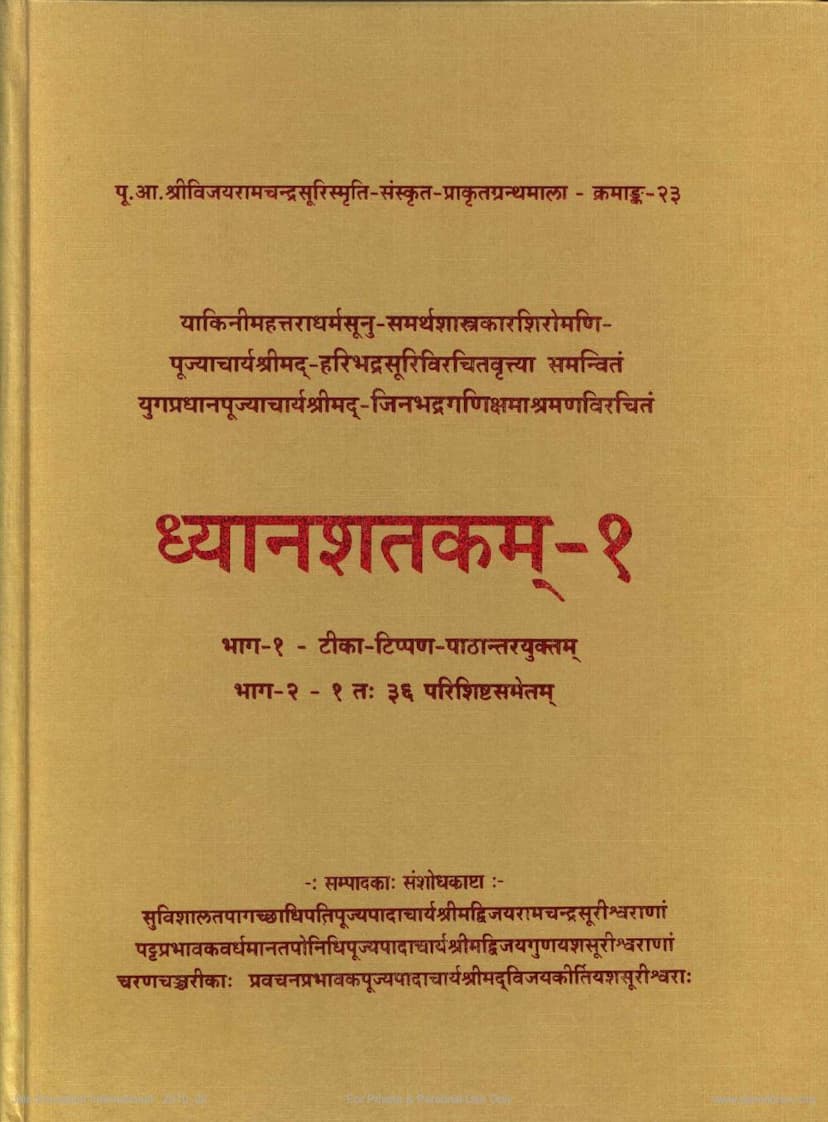Dhyanashatakam Part 1
Added to library: September 1, 2025

Summary
The provided text is a detailed table of contents and descriptive analysis of the Jain text "Dhyanashatakam Part 1". Here's a comprehensive summary in English, covering the key aspects:
Book Title: Dhyanashatakam Part 1 Author(s): Jinbhadragani Kshamashraman (primary author), Haribhadrasuri (commentator), Kirtiyashsuri (editor/compiler) Publisher: Sanmarg Prakashan Catalog Link: https://jainqq.org/explore/002559/1
Overall Purpose and Significance:
"Dhyanashatakam Part 1" (meaning "One Hundred Verses on Meditation") is a profound Jain text that delves into the intricacies of meditation (Dhyana) and related spiritual practices. It is presented as a commentary by Acharya Haribhadrasuri on the foundational work by Acharya Jinbhadragani Kshamashraman. The text emphasizes meditation as a crucial path to liberation (Moksha) and highlights its pervasiveness in all aspects of Jain spiritual conduct.
Key Components and Structure:
The book is divided into two parts:
- Part 1: Contains the original text of "Dhyanashatakam" along with its commentary (Vrutti), annotations (Tippan), and variations in readings (Pathantara).
- Part 2: Consists of 36 appendices related to "Dhyanashatakam," including references from various other Jain scriptures.
Authorship and Commentary:
- Author: Acharya Jinbhadragani Kshamashraman is identified as the author of the primary text "Dhyanashatakam." He is described as a "Yugpradhan" (an epoch-making Acharya) and a prolific scholar.
- Commentator: Acharya Haribhadrasuri, renowned as a "Samartha Shastrakar Shiromani" (foremost among brilliant scholars), provided a detailed commentary on the work.
- Editors/Compilers: The publication is credited to the disciples of Acharya Shrimad Vijayramchandrasurishwarji, specifically Acharya Shrimad Vijaygunyashasurishwarji and Acharya Shrimad Vijaykirtiyashsurishwarji, who worked under the guidance of the former.
Core Concepts Explored:
The text systematically explores the concept of meditation (Dhyana) from various angles, including:
- The Nature of Meditation: It defines meditation as a state of focused concentration of mind, speech, and body, ultimately leading to the concentration of the soul (Atma). It contrasts true meditation with mere distraction (Adhyana).
- Types of Meditation: The text meticulously details the four types of meditation:
- Arta Dhyana (Worry/Painful Meditation): Characterized by thoughts of loss, pain, suffering, and desires for things that are not present or the prevention of their loss. This type is linked to worldly suffering and lower rebirths.
- Raudra Dhyana (Fierce/Cruel Meditation): Associated with negative emotions like anger, deceit, greed, and violence. This is described as the root of suffering and rebirth in lower realms.
- Dharma Dhyana (Righteous/Virtuous Meditation): Focused on contemplation of virtuous principles, scriptures, and the path to liberation. It is associated with positive outcomes and spiritual progress.
- Shukla Dhyana (Pure/White Meditation): The highest form of meditation, characterized by profound purity and detachment, leading to omniscience and liberation. It is attained by those who have mastered Dharma Dhyana.
- Components of Meditation: The text elaborates on various aspects that facilitate meditation, such as:
- Dhyana Darshanam: The form and nature of meditation.
- Bhava Ladhya: The subtle states of the soul.
- Kayotsarga: The practice of renunciation of bodily activities.
- Dhyana Kala & Swami: The auspicious time and the qualities of the meditator.
- Dhyana Swarupa: The various types and forms of meditation.
- Dhyana dwara (Gates of Meditation): The text outlines twelve gates or aspects of Dharma Dhyana, including contemplation (Bhāvanā), place (Desha), time (Kāla), posture (Āsana), object of focus (Ālambana), sequence (Krama), object of meditation (Dhyātavya), meditator (Dhyātṛ), contemplation (Anuprekṣā), subtle states (Leshya), signs (Linga), and fruit (Phala).
- The Role of Conduct: The text emphasizes that every action of a monk and layperson should be performed with mindful attention (Dhyana), integrating it into daily conduct.
- Causality of Meditation: It explains how different types of meditation lead to specific karmic outcomes and destinations in the cycle of birth and death (Samsara), with Arta and Raudra Dhyana leading to lower realms and Dharma and Shukla Dhyana leading to higher realms and liberation.
- The Meditator (Dhyata): The text describes the qualities of an ideal meditator, emphasizing virtues like knowledge, detachment, renunciation, equanimity, and control over senses and emotions.
Editorial and Scholarly Aspects:
- The publication is part of a series dedicated to the memory of Acharya Shrimad Vijay Ramachandrasurishwarji.
- The text is presented with critical apparatus, including footnotes (Tippan) and textual variations (Pathantara), based on various manuscripts.
- The inclusion of 36 appendices in Part 2 indicates a comprehensive approach, referencing Dhyana in numerous other Jain texts and providing comparative studies.
- The introduction (Prastavana) and editor's note (Sampadakiy) provide context, discuss the lineage of Acharyas, and highlight the importance of this work.
Overall Message:
The "Dhyanashatakam" is presented as a foundational text for understanding and practicing meditation within Jainism. It is portrayed as a highly esteemed work, referenced and revered by subsequent Acharyas, and crucial for achieving spiritual progress and ultimate liberation. The text underscores that true meditation is not merely mental concentration but a profound inner absorption leading to the eradication of karma and the attainment of the soul's pure nature.